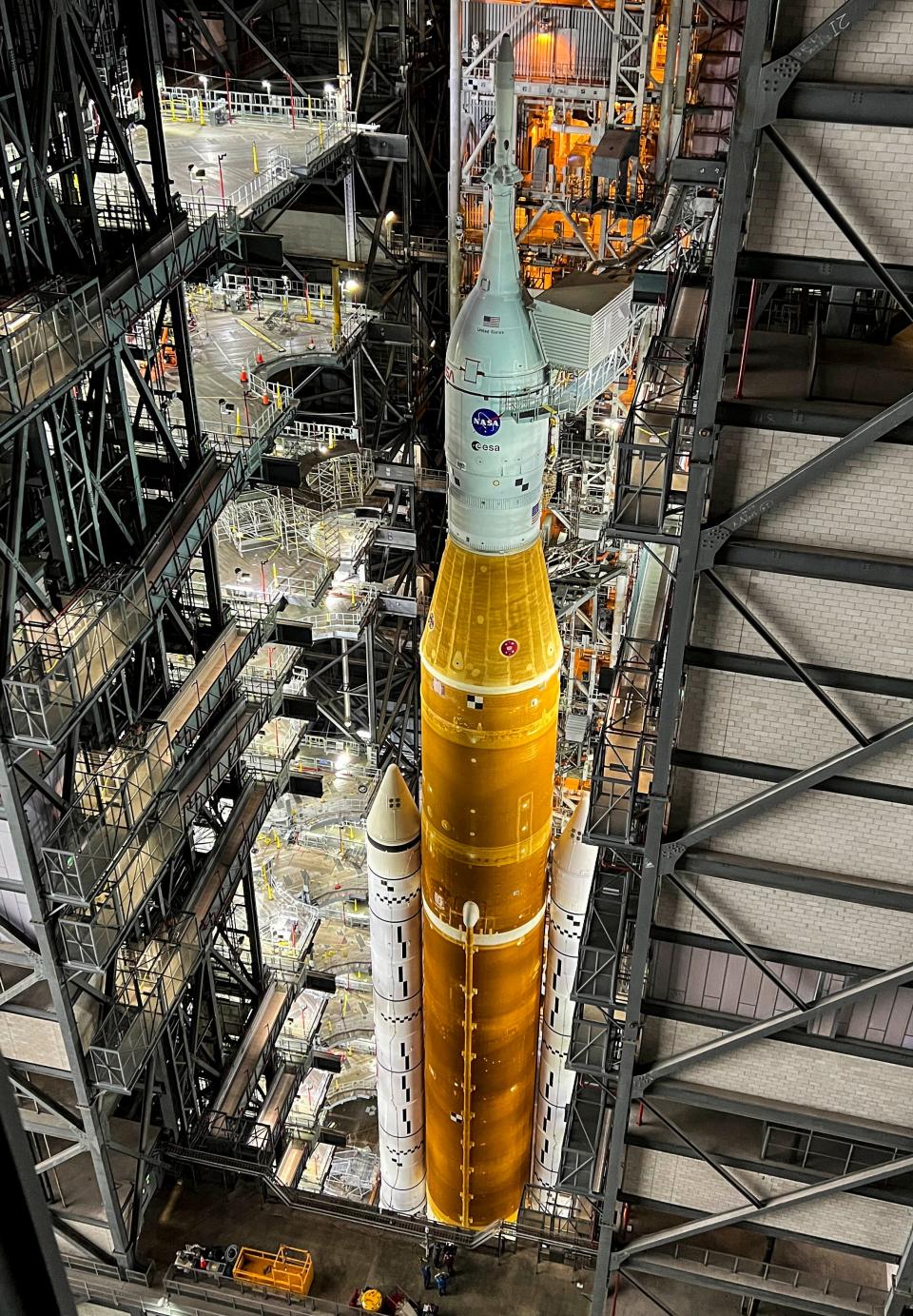NASA's mega moon rocket back on launch pad after another month-long stay in the VAB
---
At Kennedy Space Center NASA's massive moon rocket is back on its launch pad ahead of another Artemis I launch attempt set for later this month.
The agency's 322-foot Space Launch System rocket and Orion capsule were rolled out from the Vehicle Assembly Building overnight Thursday into Friday morning.
NASA's Crawler-Transporter 2 departed the VAB at 11:17 p.m. EDT Thursday. It took NASA teams about nine hours to make the nearly four-mile trek to Launch Complex 39-B arriving around 8:30 a.m. EDT Friday morning.
After two scrubbed launch attempts due to technical issues, the SLS was returned to the VAB in late September for refuge ahead of Hurricane Ian.
With the moon-bound rocket back at its launch pad teams must now work through a slew of pre-launch procedures, a process NASA officials expect to take about eight or nine days.
That timeline of course hinges on other factors like the weather, which officials continue to track closely.
The National Hurricane Center in Miami has given an area of low pressure near Puerto Rico a 40% chance of tropical cyclone development. Impacts to Central Florida are expected around mid-week.
Mark Burger, a Space Force Launch Weather Officer, told reporters Thursday, that he expects there to be "sustained winds of around 25 knots (and) potentially some rain squalls that could achieve wind gusts of 35 to 40 knots."
But he assured, "we're not looking at any likelihood, at this point, of seeing a strong system emerge out of that." Conditions are likely to remain well within constraints that the SLS is capable of withstanding while on the launch pad.
Maintenance in the VAB
During the SLS's month-long stay in its 526-foot-tall garage, NASA teams took the opportunity to recharge payload batteries and repair the layer of thermal protective cork and foam.
As a required public safety measure by the U.S. Space Force, the batteries of the flight termination system (FTS) which destroys the rocket in the event of an emergency were also replaced. The entire system was tested and recertified last weekend.
NASA's Cliff Lanham, a manager of the Exploration Ground Systems program at Kennedy Space Center, told reporters on Thursday that for launch attempts for the remainder of the year, "from an FTS standpoint, as far as the battery life, we'll be okay. We're good."
But the Space Force only certifies the FTS for 25 days at a time. After that, the batteries are required to be swapped out and the system retested. This process requires NASA to roll the rocket back each time because the work can only be completed inside the VAB.

Beyond 25 days, Lanham said, "NASA would go forward to the (Space Force) and discuss if they want to extend past the current 25-day waiver."
Next launch attempts
So far, NASA has three solid Artemis I launch opportunities within that 25-day timeframe.
If all proceeds as scheduled, the next attempt is set for Monday, Nov.14, with liftoff planned to occur during a 69-minute window that opens at 12:07 a.m. EST. It's the first SLS launch attempt to take place at night.
Beyond that, NASA has requested backup nighttime launch opportunities around the same time on Wednesday, Nov. 16, and Saturday, Nov. 19. Both offer 2-hour long launch windows.
One other opportunity on Nov. 25 — The day after Thanksgiving — may be possible, but NASA would need to get clearance from the Federal Aviation Administration before moving forward due to restrictions regarding air spaces and holiday travel.
An Artemis I launch on Monday, Nov. 14, would result in a short-duration mission around the moon of just 25-and-a-half days. In that case, the uncrewed Orion capsule would come back for a splashdown landing off the coast of California in mid-December.
For the latest, visit floridatoday.com/launchschedule.
Jamie Groh is a space reporter for Florida Today. You can contact her at JGroh@floridatoday.com. Follow her on Twitter at @AlteredJamie.
Launch Monday, November 14: NASA Artemis I
Company / Agency: NASA
Rocket: Space Launch System
Location: Pad 39B at Kennedy Space Center
Launch Time: during a 69-minute window that opens at 12:07 a.m. EST
Trajectory: Northeast
Weather: TBD
Live coverage: Starts three hours before liftoff at floridatoday.com/space
This article originally appeared on Florida Today: NASA's SLS moon rocket rolled out ahead of next Artemis I launch attempt

